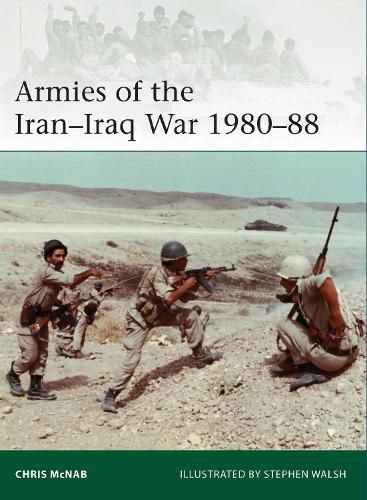Readings Newsletter
Become a Readings Member to make your shopping experience even easier.
Sign in or sign up for free!
You’re not far away from qualifying for FREE standard shipping within Australia
You’ve qualified for FREE standard shipping within Australia
The cart is loading…






Driven by the Iranian Revolution of 1979 and the insecurities it provoked in Saddam Hussein’s Iraqi dictatorship, the Iran-Iraq War would become the largest conventional conflict of the period. Curiously little-known considering its scale and longevity, the struggle between Iran and Iraq was primarily fought along the 1,458km border in a series of battles which, despite both sides being armed with modern small arms, armour and aircraft, often degenerated into attritional struggles reminiscent of World War I. Such a comparison was underlined by frequent periods of deadlock, the extensive use of trenches by both sides, and the deployment of chemical weapons by Iraq. Fully illustrated with specially commissioned artwork, this study investigates the organization, appearance and equipment of the ground forces of both sides in the Iran-Iraq War, including Iraq’s Republican Guards and Iran’s Pasdaran or Islamic Revolutionary Guard Corps. The war resulted in stalemate with some half a million dead and at least as many wounded. The financial costs incurred in waging such a long and debilitating war were one of the spurs that led Saddam Hussein to invade Kuwait barely two years later, setting in motion one of the defining currents of recent Middle-Eastern history.
$9.00 standard shipping within Australia
FREE standard shipping within Australia for orders over $100.00
Express & International shipping calculated at checkout
Stock availability can be subject to change without notice. We recommend calling the shop or contacting our online team to check availability of low stock items. Please see our Shopping Online page for more details.
Driven by the Iranian Revolution of 1979 and the insecurities it provoked in Saddam Hussein’s Iraqi dictatorship, the Iran-Iraq War would become the largest conventional conflict of the period. Curiously little-known considering its scale and longevity, the struggle between Iran and Iraq was primarily fought along the 1,458km border in a series of battles which, despite both sides being armed with modern small arms, armour and aircraft, often degenerated into attritional struggles reminiscent of World War I. Such a comparison was underlined by frequent periods of deadlock, the extensive use of trenches by both sides, and the deployment of chemical weapons by Iraq. Fully illustrated with specially commissioned artwork, this study investigates the organization, appearance and equipment of the ground forces of both sides in the Iran-Iraq War, including Iraq’s Republican Guards and Iran’s Pasdaran or Islamic Revolutionary Guard Corps. The war resulted in stalemate with some half a million dead and at least as many wounded. The financial costs incurred in waging such a long and debilitating war were one of the spurs that led Saddam Hussein to invade Kuwait barely two years later, setting in motion one of the defining currents of recent Middle-Eastern history.